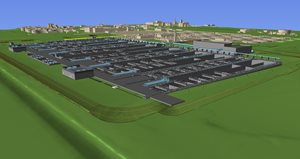The Sacramento Regional County Sanitation District (Regional San) is proceeding with a $1.5-billion to $2.1-billion plan to upgrade its wastewater treatment plant that serves about 1.4 million customers. On June 2, Regional San issued a request for proposals for construction management services for work valued at $127 million to perform site preparation beginning in Feb. 2015, and build a nitrifying sidestream treatment facility, disinfection chemical storage and RAS pumping system.


Carollo Engineers, Walnut Creek, Calif., is designing the RAS system, while site prep design was performed by Kennedy Jenks Consultants, Sacramento.
Built in the late 1970s, the existing plant is permitted to treat and discharge 181 million gallons per day into the Sacramento River, but new state water quality regulations dictate additional treatment to remove ammonia and nitrates, small particles and pathogens.
Dubbed EchoWater, the upgrade will include construction of a $600-million biological nutrient removal facility, sited next to the existing plant. The BNR is about the size of 20 football fields and one of the largest in the nation, says a Regional San representative. Granular media filtration and enhanced disinfection will also be added to the facility.
While ratepayers will see an increase in water service fees due to the project, Regional San officials expect that revenue generated by water reuse and recycling for irrigation to help offset future maintenance and operation costs.
A second RFP package coming later this year will include the BNR, designed by Overland Park, Kansas-based Black & Veatch, and the primary effluent pumping station, designed by Englewood, Colo.-based CH2M Hill. The pumping station work will also include extending the existing primary effluent channel and constructing new pipelines. Construction on that package begins Feb. 2016.
Completion of the entire facility is expected by 2023.



